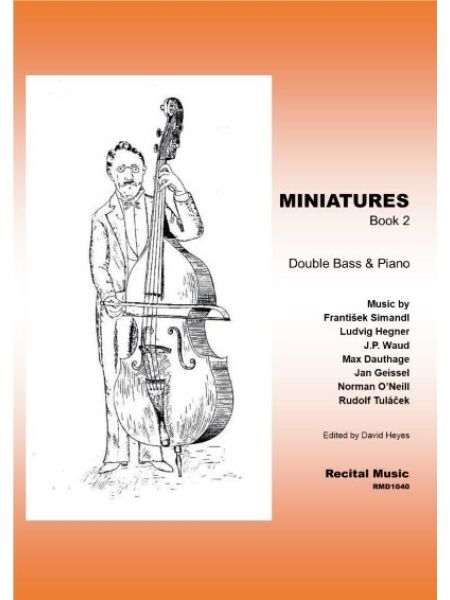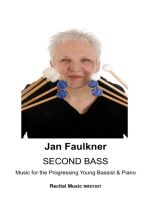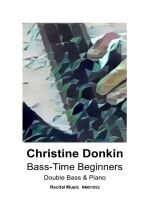Miniatures Book 2

Product code:
£10.00
Description
František [Franz] Simandl (1840-1912) was one of the leading bassists and teachers of his generation and studied double bass at the Prague Conservatoire with Josef Hrabě. He became a member of the Vienna Philharmonic and taught at the Vienna Conservatoire, teaching many bassists who exported the Czech double bass school to every corner of the world. Although Simandl’s music has fallen from favour in recent times, he was a pioneer of his day and his New Method for Double Bass helped succeeding generations to build and develop the standard of double bass playing today.
avatine Op.67 was first published in 1903 by C.F Schmidt as part of Simandl’s ground-breaking eight volume series of original works and transcriptions for double bass. In ternary form, a lyrical opening theme emphasises the lyrical and cantabile qualities of the double bass with a gently supportive accompaniment which adds colour and interest. A more animated middle section, alongside dramatic mood swings, is more technically charged before the opening music returns, ending in the highest register of the double bass.
Ludvig Hegner (1851-1923) studied theory and composition with Niels Gade and in 1884 became a member of the Danish Royal Theatre Orchestra, promoted two months later to the position of Principal Bass. Alongside his orchestral duties, Hegner also gave many solo performances, often playing his own works or those of his fellow bassist-composers such as Bottesini or Simandl, and after a solo performance in America, the New York Times compared Hegner to the great Dragonetti and Bottesini. Ludvig Hegner composed a number of works for double bass, which fall into the category of ‘characteristic’ or ‘salon’ music, and are typical of music being written and performed at the end of the 19th-century.
Nocturne Op.6 is charming and well written for the double bass making effective use of the entire range of the instrument, including its lower register. A number of contrasting themes explore the lyrical and dramatic possibilities of the solo double bass with a chordal accompaniment which adds character and momentum.
Joseph Pritchard Waud (1833-1905) was born in Chelsea (London) on 30 July 1833, and in the 1861 census, he was 26 years old and described as “proffesser of music,” but in later census entries, he was a “teacher of music.” He married Eliza Walford in 1858, and the disparity in age between husband and wife, taken from each census, ranges from two or four to seven years. They had three children, a son who died at the age of four or five and two daughters who also became music teachers. J.P. Waud’s biography on a family tree website states:
He performed on the pianoforte, double bass, and violoncello, is engaged at the Crystal Palace in the permanent band of the company also at the Theatre Royal Haymarket, and at various concerts. He also has private teaching… Joseph Pritchard Waud died on 7 July 1905 in Hove, West Sussex at the age of 71.
Solo Study No.2 is from a suite of Six Solos Studies for the Double Bass with Pianoforte Accompaniment but the printed edition gives no information about the date of composition or the publisher. Solo Study No.2 is slow and rhapsodic, using the middle register of the double bass, including thumb position, contrasting a gently arpeggiated piano accompaniment. The style is tonal and traditional and this could easily be subtitled a ‘song without words’.
Austrian bassist-composer Max Dauthage (1862-1937) studied at the Vienna Conservatoire with František Simandl. He completed his studies in 1884 and joined the Vienna Philharmonic Orchestra, where he played until his retirement in 1918. Dauthage taught at the Vienna Conservatoire from 1910-1931 and composed a number of recital and educational works for the double bass.
Albumblatt (Album leaf) is the second piece from 20 Melodische Übungsstücke, published in 1911 by Universal Edition (Vienna/Leipzig). Originally untitled, Recital Music has added a new and descriptive title to each piece and Albumblatt is evocative and lyrical. The slow-moving chordal accompaniment contrasts long cantabile solo lines and its late-romantic styles is instantly appealing and enjoyable.
Jan [Johann] Geissel (1859-1919) was a Czech double bassist, teacher and composer. He was born in Pardubice and studied double bass at Prague Conservatoire with Josef Sládek from 1873-76 and with Vendelin Sládek from 1876-79. He spent much of his life in Strasburg (Germany) and taught at Strasburg Conservatoire also played in the opera orchestra, and died in the city in 1919. Jan Geissel composed a number of works for double bass including a Concerto Op.32, many short incidental pieces and a Concertstück Op.24 which was dedicated to František Simandl. His music is well written for the double bass, utilising the entire solo register by exploring and demonstrating the technical prowess and lyrical qualities of the instrument.
Concert-Ländler (Op.39, No.2) is full of old-fashioned charm and elegance. Waltz-like melodies in the higher register, emphasising the lyrical potential of the double bass, contrast a simple, chordal and supportive accompaniment, creating music which is both player and audience friendly.
Norman O’Neill (1875-1934) was the leading British theatrical composer in the 1920s and 30s. He composed music for more than 50 plays, notably by J.M. Barrie, Shakespeare, A.A. Milne, Ibsen, Walter Scott and Ashley Dukes, showing a remarkable aptitude for devising music which enhanced a situation and reflected the stage characters. He studied with Arthur Somervell and subsequently with Iwan Knorr in Frankfurt, alongside fellow students Balfour Gardiner, Percy Grainger, Cyril Scott and Roger Quilter – subsequently nicknamed ‘the Frankfurt gang’. O’Neill was Musical Director of the Haymarket Theatre (London) from 1908-19 and returned there in 1920 for the production of J.M. Barrie’s ‘Mary Rose’ – one of his most successful scores.
Soliloquy is a short lyrical solo, originally in solo tuning, and was composed in 1926 for Victor Watson and his 3-stringed double bass. Utilising the full solo range of the instrument, it employs long, expansive melodies and a wistful quality, and Delius-like harmonies, produce a work of great quality and beauty. There are musical and technical challenges aplenty and scope to display the solo possibilities of the instrument. The manuscript was re-discovered by David Heyes in 2005, who gave the modern premiere on 2 October 2005, and was unpublished until Recital Music’s first edition.
Czech bassist-composer, Rudolf Tuláček (1885-1954) studied at Prague Conservatoire with František Černý, was solo double bass of Zagreb Philharmonic Orchestra for many years and in 1937 moved to Brno (Czech Republic) where he was appointed Professor of double bass at the Academy of Music. Tuláček wrote a number of lyrical and characteristic works for double bass at the beginning of the 20th-century and wrote in a tonal and late-romantic style, reminiscent of much salon music of the time.
Feuille d’Album (Album-leaf) was composed in 1903 and is typical of the salon music of the day. Expressive and evocative melodies emphasise the singing qualities of the double bass, with a gently supportive piano accompaniment which never overshadows the solo line.
“Expressive and fluid shifting will highlight the work’s lyrical qualities, as the 6/8 theme meanders wistfully up and down the G string, avoiding the lower register.”
(Double Bassist)
“…the vocal character of the repeated and varied melodic motives are reminiscent of other works by Tuláček’s composition teacher Dvořák.” (ISB)
Description
František [Franz] Simandl (1840-1912) was one of the leading bassists and teachers of his generation and studied double bass at the Prague Conservatoire with Josef Hrabě. He became a member of the Vienna Philharmonic and taught at the Vienna Conservatoire, teaching many bassists who exported the Czech double bass school to every corner of the world. Although Simandl’s music has fallen from favour in recent times, he was a pioneer of his day and his New Method for Double Bass helped succeeding generations to build and develop the standard of double bass playing today.
avatine Op.67 was first published in 1903 by C.F Schmidt as part of Simandl’s ground-breaking eight volume series of original works and transcriptions for double bass. In ternary form, a lyrical opening theme emphasises the lyrical and cantabile qualities of the double bass with a gently supportive accompaniment which adds colour and interest. A more animated middle section, alongside dramatic mood swings, is more technically charged before the opening music returns, ending in the highest register of the double bass.
Ludvig Hegner (1851-1923) studied theory and composition with Niels Gade and in 1884 became a member of the Danish Royal Theatre Orchestra, promoted two months later to the position of Principal Bass. Alongside his orchestral duties, Hegner also gave many solo performances, often playing his own works or those of his fellow bassist-composers such as Bottesini or Simandl, and after a solo performance in America, the New York Times compared Hegner to the great Dragonetti and Bottesini. Ludvig Hegner composed a number of works for double bass, which fall into the category of ‘characteristic’ or ‘salon’ music, and are typical of music being written and performed at the end of the 19th-century.
Nocturne Op.6 is charming and well written for the double bass making effective use of the entire range of the instrument, including its lower register. A number of contrasting themes explore the lyrical and dramatic possibilities of the solo double bass with a chordal accompaniment which adds character and momentum.
Joseph Pritchard Waud (1833-1905) was born in Chelsea (London) on 30 July 1833, and in the 1861 census, he was 26 years old and described as “proffesser of music,” but in later census entries, he was a “teacher of music.” He married Eliza Walford in 1858, and the disparity in age between husband and wife, taken from each census, ranges from two or four to seven years. They had three children, a son who died at the age of four or five and two daughters who also became music teachers. J.P. Waud’s biography on a family tree website states:
He performed on the pianoforte, double bass, and violoncello, is engaged at the Crystal Palace in the permanent band of the company also at the Theatre Royal Haymarket, and at various concerts. He also has private teaching… Joseph Pritchard Waud died on 7 July 1905 in Hove, West Sussex at the age of 71.
Solo Study No.2 is from a suite of Six Solos Studies for the Double Bass with Pianoforte Accompaniment but the printed edition gives no information about the date of composition or the publisher. Solo Study No.2 is slow and rhapsodic, using the middle register of the double bass, including thumb position, contrasting a gently arpeggiated piano accompaniment. The style is tonal and traditional and this could easily be subtitled a ‘song without words’.
Austrian bassist-composer Max Dauthage (1862-1937) studied at the Vienna Conservatoire with František Simandl. He completed his studies in 1884 and joined the Vienna Philharmonic Orchestra, where he played until his retirement in 1918. Dauthage taught at the Vienna Conservatoire from 1910-1931 and composed a number of recital and educational works for the double bass.
Albumblatt (Album leaf) is the second piece from 20 Melodische Übungsstücke, published in 1911 by Universal Edition (Vienna/Leipzig). Originally untitled, Recital Music has added a new and descriptive title to each piece and Albumblatt is evocative and lyrical. The slow-moving chordal accompaniment contrasts long cantabile solo lines and its late-romantic styles is instantly appealing and enjoyable.
Jan [Johann] Geissel (1859-1919) was a Czech double bassist, teacher and composer. He was born in Pardubice and studied double bass at Prague Conservatoire with Josef Sládek from 1873-76 and with Vendelin Sládek from 1876-79. He spent much of his life in Strasburg (Germany) and taught at Strasburg Conservatoire also played in the opera orchestra, and died in the city in 1919. Jan Geissel composed a number of works for double bass including a Concerto Op.32, many short incidental pieces and a Concertstück Op.24 which was dedicated to František Simandl. His music is well written for the double bass, utilising the entire solo register by exploring and demonstrating the technical prowess and lyrical qualities of the instrument.
Concert-Ländler (Op.39, No.2) is full of old-fashioned charm and elegance. Waltz-like melodies in the higher register, emphasising the lyrical potential of the double bass, contrast a simple, chordal and supportive accompaniment, creating music which is both player and audience friendly.
Norman O’Neill (1875-1934) was the leading British theatrical composer in the 1920s and 30s. He composed music for more than 50 plays, notably by J.M. Barrie, Shakespeare, A.A. Milne, Ibsen, Walter Scott and Ashley Dukes, showing a remarkable aptitude for devising music which enhanced a situation and reflected the stage characters. He studied with Arthur Somervell and subsequently with Iwan Knorr in Frankfurt, alongside fellow students Balfour Gardiner, Percy Grainger, Cyril Scott and Roger Quilter – subsequently nicknamed ‘the Frankfurt gang’. O’Neill was Musical Director of the Haymarket Theatre (London) from 1908-19 and returned there in 1920 for the production of J.M. Barrie’s ‘Mary Rose’ – one of his most successful scores.
Soliloquy is a short lyrical solo, originally in solo tuning, and was composed in 1926 for Victor Watson and his 3-stringed double bass. Utilising the full solo range of the instrument, it employs long, expansive melodies and a wistful quality, and Delius-like harmonies, produce a work of great quality and beauty. There are musical and technical challenges aplenty and scope to display the solo possibilities of the instrument. The manuscript was re-discovered by David Heyes in 2005, who gave the modern premiere on 2 October 2005, and was unpublished until Recital Music’s first edition.
Czech bassist-composer, Rudolf Tuláček (1885-1954) studied at Prague Conservatoire with František Černý, was solo double bass of Zagreb Philharmonic Orchestra for many years and in 1937 moved to Brno (Czech Republic) where he was appointed Professor of double bass at the Academy of Music. Tuláček wrote a number of lyrical and characteristic works for double bass at the beginning of the 20th-century and wrote in a tonal and late-romantic style, reminiscent of much salon music of the time.
Feuille d’Album (Album-leaf) was composed in 1903 and is typical of the salon music of the day. Expressive and evocative melodies emphasise the singing qualities of the double bass, with a gently supportive piano accompaniment which never overshadows the solo line.
“Expressive and fluid shifting will highlight the work’s lyrical qualities, as the 6/8 theme meanders wistfully up and down the G string, avoiding the lower register.”
(Double Bassist)
“…the vocal character of the repeated and varied melodic motives are reminiscent of other works by Tuláček’s composition teacher Dvořák.” (ISB)



